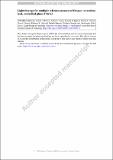| dc.contributor.author | Mateen, Farrah J | |
| dc.contributor.author | Vogel, Andre C | |
| dc.contributor.author | Kaplan, Tamara B | |
| dc.contributor.author | Hotan, Gladia C | |
| dc.contributor.author | Grundy, Sara J | |
| dc.contributor.author | Holroyd, Kathryn B | |
| dc.contributor.author | Manalo, Natalie | |
| dc.contributor.author | Stauder, Matthew | |
| dc.contributor.author | Videnovic, Aleksandar | |
| dc.date.accessioned | 2021-09-20T17:16:59Z | |
| dc.date.available | 2021-09-20T17:16:59Z | |
| dc.date.issued | 2020-04-24 | |
| dc.identifier.uri | https://hdl.handle.net/1721.1/131420 | |
| dc.description.abstract | Abstract
Background
Bright white light therapy (LT) can improve fatigue in several disease states but has not been studied in multiple sclerosis (MS).
Objective
To determine whether controlled home-based LT is feasible, tolerable, and well-adhered to in MS-associated fatigue.
Methods
A randomized, controlled trial of twice-daily 1-h bright white LT (BWLT) (10,000 lx, active arm) versus dim red LT (DRLT) (< 300 lx, control arm) was performed. Adults with MS-associated fatigue were enrolled for 10 weeks: 2-week baseline, 4-week intervention, 4-week washout.
Results
41 participants were enrolled; 35 were randomized (average age 42 years, 80% female; BWLT n = 20; DRLT n = 15). 31 were in the intention to treat analysis. The average duration of LT sessions was similar between groups (BWLT 60.9 min, DRLT 61.5 min, p = 0.70). The most commonly reported adverse event was headache. There were no events that led to discontinuation. Baseline fatigue was severe in both arms (each 53/63 points on the Fatigue Severity Scale (FSS), p = 0.92). FSS was lower following BWLT (FSS 45.8 post-LT, p = 0.04; 44.9 post-washout, p = 0.02 intra-group compared to baseline FSS) and DRLT (FSS 46.7 post-LT, p = 0.03; 43.9 post-washout, p = 0.002 intragroup compared to baseline FSS). There was no difference between BWLT and DRLT groups in the magnitude of reduction of FSS scores (p = 0.81 after LT; p = 0.77 after washout for between group comparisons). Similarly, MS quality of life metrics improved in both arms but were not significantly different between groups after LT (p = 0.22) or washout.
Conclusions
LT is safe, feasible, and well-tolerated in people with MS-associated fatigue. Improvement in both light spectra likely indicates a strong placebo effect for the DRLT group. | en_US |
| dc.publisher | Springer Berlin Heidelberg | en_US |
| dc.relation.isversionof | https://doi.org/10.1007/s00415-020-09845-w | en_US |
| dc.rights | Article is made available in accordance with the publisher's policy and may be subject to US copyright law. Please refer to the publisher's site for terms of use. | en_US |
| dc.source | Springer Berlin Heidelberg | en_US |
| dc.title | Light therapy for multiple sclerosis-associated fatigue: a randomized, controlled phase II trial | en_US |
| dc.type | Article | en_US |
| dc.contributor.department | Massachusetts Institute of Technology. Department of Brain and Cognitive Sciences | |
| dc.eprint.version | Author's final manuscript | en_US |
| dc.type.uri | http://purl.org/eprint/type/JournalArticle | en_US |
| eprint.status | http://purl.org/eprint/status/PeerReviewed | en_US |
| dc.date.updated | 2020-09-24T20:57:12Z | |
| dc.language.rfc3066 | en | |
| dc.rights.holder | Springer-Verlag GmbH Germany, part of Springer Nature | |
| dspace.embargo.terms | Y | |
| dspace.date.submission | 2020-09-24T20:57:12Z | |
| mit.license | PUBLISHER_POLICY | |
| mit.metadata.status | Authority Work and Publication Information Needed | |
